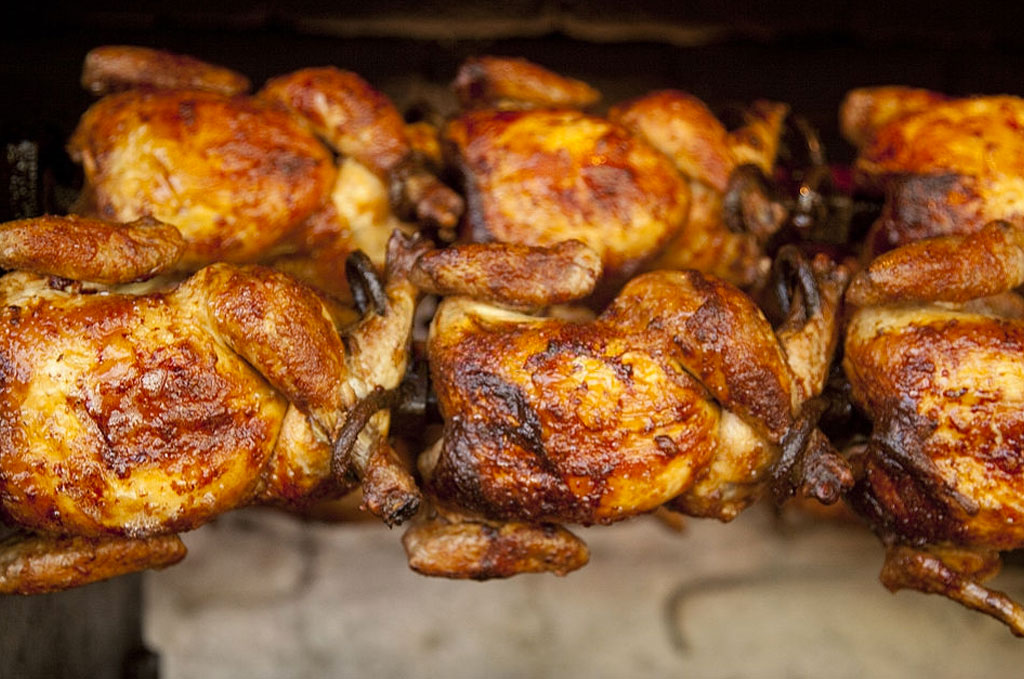If you’ve ever enjoyed a Thanksgiving dinner, chances are you’re fond of the idea of sitting around a table with a big bird and your family. Food marketers capitalize on this idea constantly with images of families sitting in the comfort of a franchise booth, happily chatting and eating their sauce-slathered chicken with no fewer than two starchy sides and a soda. Swiss Chalet now has a commercial on the TV where the family is thankful that their picnic got rained out so they could eat there instead. I think it’s safe to say that we’re fond of chicken dinners if we prefer them to have a picnic with our family! So I guess the real question is, why should you learn to cook a chicken dinner when you can just go to Swiss Chalet?
Well, there are many reasons, but first I have but one thing to say in defense of chicken franchises that I’ve heard people (OK, not people, vegetarians) criticize. That is, that they inject salt and sugar into the meat, to make it taste better, to make it more addictive, or for whatever purpose it is supposed to serve. I am unaware of whether or not this is actually true, but it would not surprise me if it were. A simple salt-sugar solution injected or somehow saturated into the meat of a chicken, is called brine. It’s not really a secret fast-food trick, it’s a technique that’s been used for ages for cooking pretty much all Earth-dwelling animals. Your roasted chicken will benefit from a soak in brine as much as a barbecued pork chop will. It helps thoroughly season the meat and retain its juices when it is cooked. Try it some time, just dissolve 1 cup of salt and 1/2 cup of sugar in a gallon of boiling water, let it cool to room temperature, and then soak your meat in it for several hours. Remove the meat, discard the brine, rinse it off, pat it dry and cook it however you normally would.
If the chickens prepared at these establishments are in fact brined, it is my opinion that they are yielding little benefit from it. The chickens are cooked and then kept at a warming temperature for so long sometimes that the texture of the meat completely changes. The natural juices of the chicken leech out, the skin starts to wrinkle. The result is unpleasant, but it is served with gravy or barbecue sauce that adequately disguises it. It is no surprise to me that the Western world has adopted a palette for flavorless white meat when this is the chicken they’ve been taught to love.
I am not opposed to the mechanical rotisserie system. I have eaten my fair share of supermarket rotisserie-style chickens. I say rotisserie-style because it’s a total misnomer if you’ve ever had a spit-roasted chicken — true rotisserie. They’re convenient and inexpensive. They’re good for quick picnics. The cold leftovers are perfect for instant sandwiches and salad toppings. When they’re fresh, they make reasonable meals when you’re too busy to actually cook something. When they’re not fresh, they too fall victim to heat lamps and leave behind a shriveling, leathery carcass. You’re better off eating something else from the deli case at that point.
So, you should learn to roast your own chicken because you will always end up with something that you want to eat. It will taste better. It will be fresh when you’re ready to eat it. You’ll know exactly what is and what’s not going into it, which means you can flavor it however you want and keep preservatives, hydrogenated oils, and excess salt and sugar out of your food. Not only will your end result be healthier and more flavorful, but it will be cheaper, too. At the Portuguese market across the street from my loft, where I often do my shopping strictly based on close proximity and value for my money, I can buy a halal chicken for $4.99. I don’t really understand the prevalence of halal products next to the bacon and Portuguese pork sausages in the cooler, but a $4.99 chicken is a good deal. These are broiler-fryer chickens, ranging around the 3-pound mark, which is the perfect size for a chicken. Perfect, that is, for cooking quickly and replacing those over-cooked supermarket rotisserie chickens.
Roasting a chicken is not difficult and it need not be scary. This method of roasting a chicken requires a little bit of prep work, but it cooks faster and produces succulent meat with crispy skin, so it is worth it.
Quick-Roasted Chicken
Ingredients:
- One 3-4 pound broiler-fryer chicken
- 1/2 cup marinade*
- 2-3 tablespoons vegetable oil
- salt and pepper
Directions:
Adjust your oven rack to the second-highest setting, about 8″ away from your broiler and preheat the broiler to high.
Remove any twine the chicken may have been trussed with and any giblets that might be in the cavity. Wash the bird and pat it dry with a paper towel.
Butterfly the chicken using either of the methods outlined below**.
Gently pry the skin away from the meat with your fingers. You want to be able to season the meat with your marinade and then use the skin to protect it from burning, so try not to completely remove it from the bird or tear it. Make sure you pry the skin away from every part you want to eat, which should be all of it. Some places are hard to reach but the end result will be worth it.
Massage the marinade into the meat, making sure to get into the hard to reach places in the legs and all the way to the back. Recover the meat with the skin as well as possible.
Rub the skin with vegetable oil and season liberally with salt and pepper. This works best with two people, since one can turn the bird as the other seasons, but do what you can to cover as much of the skin as possible.
Put the chicken skin-side up on a high-rimmed baking sheet or a roasting pan and pop it in the oven. A little trick I learned from Alton Brown is to pry the oven door open because some ovens automatically turn the broiler off when it reaches a certain temperature. You want it to stay as hot as possible because we’re trying to cook this thing as quickly as possible and yield crispy skin, which is delicious.
Don’t forget to wash your hands really well with soap and water.
Within 10 minutes, you should hear a lot of sizzling. If the skin is starting to crisp up and get brown, grab your trusty oven mitts, take the chicken out and turn it over. If not, wait a couple more minutes, it shouldn’t belong. If there is a lot of fat that has dripped off the bird, discard it to an empty can. You can use this fat to roast potatoes in, which is fantastic, but if you don’t do it the same night as the chicken you’ll probably want to just throw it away.
In another 10 minutes, this side should also be browned. Remove the chicken from the oven, flip over so that the skin side is exposed once more, drain the pan again, and reduce the oven temperature to 450 degrees.
Return the chicken to the lower portion of the oven and roast it until it is done. If you’ve got an oven thermometer, it should register at around 170 degrees in both the thigh and the breast. I would estimate this will take about 30-40 minutes longer. If you notice that the skin is starting to blacken instead of brown, cover it tightly with tinfoil, unless you’re into the Cajun thing, then just ignore the smoke.
When the chicken is cooked, remove it from the oven and let it rest. These means don’t poke it anymore, don’t try to carve it, don’t even touch it for at least 15 minutes. The house will smell fantastic and you’ll be starving, but it’s crucial to wait. All those juices that run all over your counter when you cut into it too soon could’ve been locked into the meat. This is key! LET THE MEAT REST. THEN carve it and eat it.
*MARINADE
The marinade pictured is simply a Portuguese rub called vinha d’alho that I picked up at the supermarket. It’s a blend of red peppers, garlic, wine, bay leaf, and salt. Shannon says it tastes just like the Portuguese grills here, which stands to reason. Piri piri would also be a good option. You’ve got seemingly unlimited options for what to use in its place. Barbecue sauce, herb butter, tomato sauce, pesto, teriyaki sauce, curry paste, leftover tuna salad… basically, anything that will supply flavor and moisture to the chicken.
**BUTTERFLYING METHOD #1
Lay the chicken on its back and, with a sharp knife, cut through the skin and flesh on both sides of the breast bone. Remove the breast bone and lay the chicken flat, skin side up.
This is the best way to butterfly the chicken for ease of prying the skin back, making it easier to season the meat. I also find it generally cooks faster and more evenly. The downside is that it does not carve as easily.
**BUTTERFLYING METHOD #2
The second way is basically the same procedure, upside down. Lay the chicken on its breasts and, with a sharp knife or kitchen shears, cut on either side of the backbone. Remove the backbone and lay the chicken flat, skin side up.
This is the best way to butterfly the chicken for ease of carving since you can simply cut away the legs (thigh and drumstick) and then slice down the center of the breasts to easily portion the whole chicken into four.
When you’re removing the bones, you don’t have to be pretty about it. Just rip that bone out. You’re looking for a quick dinner here. Rustic is fine if you’re cooking for nobody special, like yourself, friends and/or family. If there’s an important guest, roast the chicken whole with pieces of tinfoil strategically placed to make it look like it is wearing a bikini. I have not tried this yet myself, presumably because I’ve never had important company, but perhaps I will make a post about this one day in the future.
I like to continue using the knife or shears to cut around the joint or snip off the wings and remove them entirely. I can then use them for stock or, hey, chicken wings. You’ll have to make quite a few roasted chickens to gather enough chicken wings to make it worthwhile, but that’s why your fridge comes attached to a freezer. You don’t necessarily have to remove them, but they’ll basically just cook so quickly that they’ll burn from being so close to the heat or, at best, get really tough. It’s up to you. I don’t know anyone that tries to fight for the wings when it’s carving time.
Since there is a lot of downtimes while the chicken is just roasting away, you have plenty of time to prepare some side dishes for your meal or catch up on syndicated episodes of Seinfeld. What’s the deal with those rotisserie chickens, anyway?







